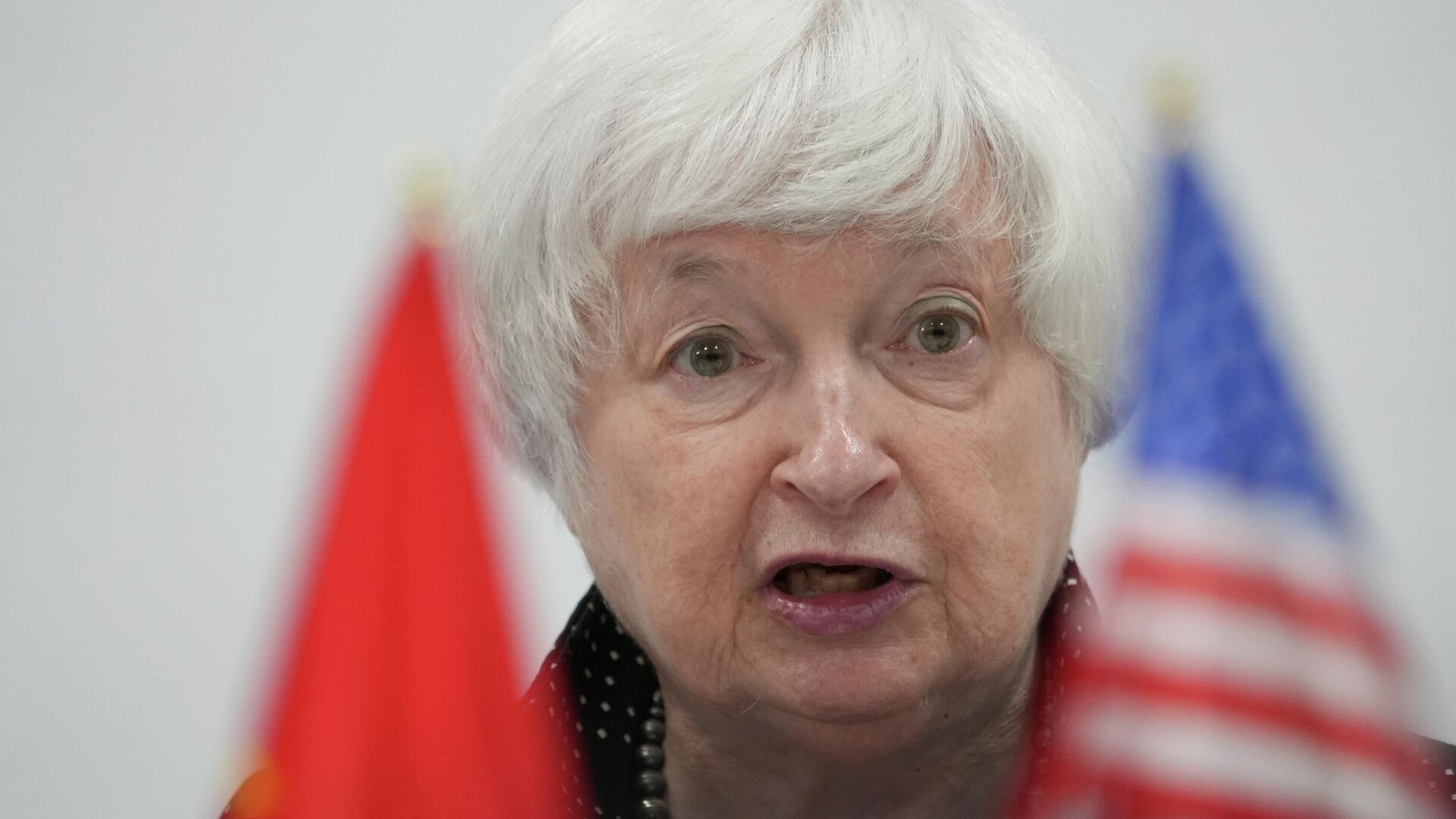https://sputnikglobe.com/20230918/yellen-says-us-on-sustainable-course-as-national-debt-hits-33-trillion-1113479040.html
Yellen Says US on ‘Sustainable Course’ as National Debt Hits $33 Trillion
Yellen Says US on ‘Sustainable Course’ as National Debt Hits $33 Trillion
Sputnik International
The US National Debt reached $33 trillion on Monday, the Treasury announced on Monday, marking a milestone amid tense political negotiations over spending in Washington.
2023-09-18T21:18+0000
2023-09-18T21:18+0000
2023-09-18T21:16+0000
janet yellen
national debt
us debt ceiling crisis
budget deficit
us
economy
https://cdn1.img.sputnikglobe.com/img/07e7/08/0f/1112621523_0:172:3066:1897_1920x0_80_0_0_cd8ecb41feee7a700f6795c1d4089272.jpg
The US Treasury Department revealed the national debt reached $33 trillion on Monday, marking a milestone amid tense political negotiations over spending in Washington.The debt is made up of a mixture of intergovernmental holdings and debt owed to the public via savings bonds. It has grown steadily over the years as borrowing against the government has been used to fund government operations, accelerating since the early 21st century amid a slew of new US wars, governmental programs, and economic crises into which the federal government has stepped to stabilize and restart the economy.The national debt has become a major political battleground, with Republicans who are ideologically opposed to further federal spending on various programs refusing to agree to lift the debt ceiling - a congressional spending limit - without Democrats agreeing to considerable budget cuts. The most recent showdown in the spring of 2023 saw the federal government come within days of defaulting on its debt before the two parties agreed to a deal that would allow the government to spend more money servicing its debts.Another budget showdown in Washington playing out this week is part of the fallout of the June debt ceiling deal, as lawmakers struggle to agree on a set of spending bills that are necessary to keep the federal government operating beyond September 30, the end of the fiscal year. Without a deal, major parts of the federal government will be forced to halt operations until new spending can be arranged.Speaking to US media on Monday, US Treasury Secretary Janet Yellen said she was comfortable with the current state of the federal budget.“We have to make sure that we do keep deficits under control going out,” she also said. “The statistic or metric that I look at most often to judge the fiscal, our fiscal course is net interest as a share of GDP [gross domestic product]. And even with the rise we’ve seen in interest rates, that remains at a very reasonable level of around 1%, but we’d need to be careful about what we do going forward in order to make sure we stay on this sustainable course.”
https://sputnikglobe.com/20230912/us-child-poverty-doubled-in-2022-after-biden-admin-let-pandemic-economic-programs-expire-1113323203.html
Sputnik International
feedback@sputniknews.com
+74956456601
MIA „Rossiya Segodnya“
2023
News
en_EN
Sputnik International
feedback@sputniknews.com
+74956456601
MIA „Rossiya Segodnya“
Sputnik International
feedback@sputniknews.com
+74956456601
MIA „Rossiya Segodnya“
us national debt; janet yellen; treasury department; government shutdown
us national debt; janet yellen; treasury department; government shutdown
Yellen Says US on ‘Sustainable Course’ as National Debt Hits $33 Trillion
In the time since 2001, the US federal government has never run a surplus, thanks to the spending hikes but also massive tax cuts, which in US politics are commonly credited with increasing economic activity and bettering the lives of citizens.
The US Treasury Department revealed the national debt reached $33 trillion on Monday, marking a milestone amid tense political negotiations over spending in Washington.
The debt is made up of a mixture of intergovernmental holdings and debt owed to the public via savings bonds. It has grown steadily over the years as borrowing against the government has been used to fund government operations,
accelerating since the early 21st century amid a slew of new US wars, governmental programs, and economic crises into which the federal government has stepped to stabilize and restart the economy.
The national debt has become a major political battleground, with Republicans who are ideologically opposed to further federal spending on various programs refusing to agree to lift the debt ceiling - a congressional spending limit - without Democrats agreeing to considerable budget cuts. The most recent showdown in the spring of 2023 saw the federal government
come within days of defaulting on its debt before the two parties agreed to a deal that would allow the government to spend more money servicing its debts.
The close call led to a further downgrade of the US government’s credit rating, raising new fears of an economic downturn in the future as lenders might come to see the government as a risky investment.
Another budget showdown in Washington playing out this week is part of the fallout of the June debt ceiling deal, as lawmakers struggle to agree on a set of spending bills that are necessary to
keep the federal government operating beyond September 30, the end of the fiscal year. Without a deal, major parts of the federal government will be forced to halt operations until new spending can be arranged.

12 September 2023, 20:09 GMT
Speaking to US media on Monday, US Treasury Secretary Janet Yellen said she was comfortable with the current state of the federal budget.
“Certainly greater deficit reduction is possible,” Yellen said. “The president has proposed a series of measures that would reduce our deficits over time while investing in the economy and this is something we need to do going forward.”
“We have to make sure that we do keep deficits under control going out,” she also said. “The statistic or metric that I look at most often to judge the fiscal, our fiscal course is net interest as a share of GDP [gross domestic product]. And even with the rise we’ve seen in interest rates, that remains at a very reasonable level of around 1%, but we’d need to be careful about what we do going forward in order to make sure we stay on this sustainable course.”



